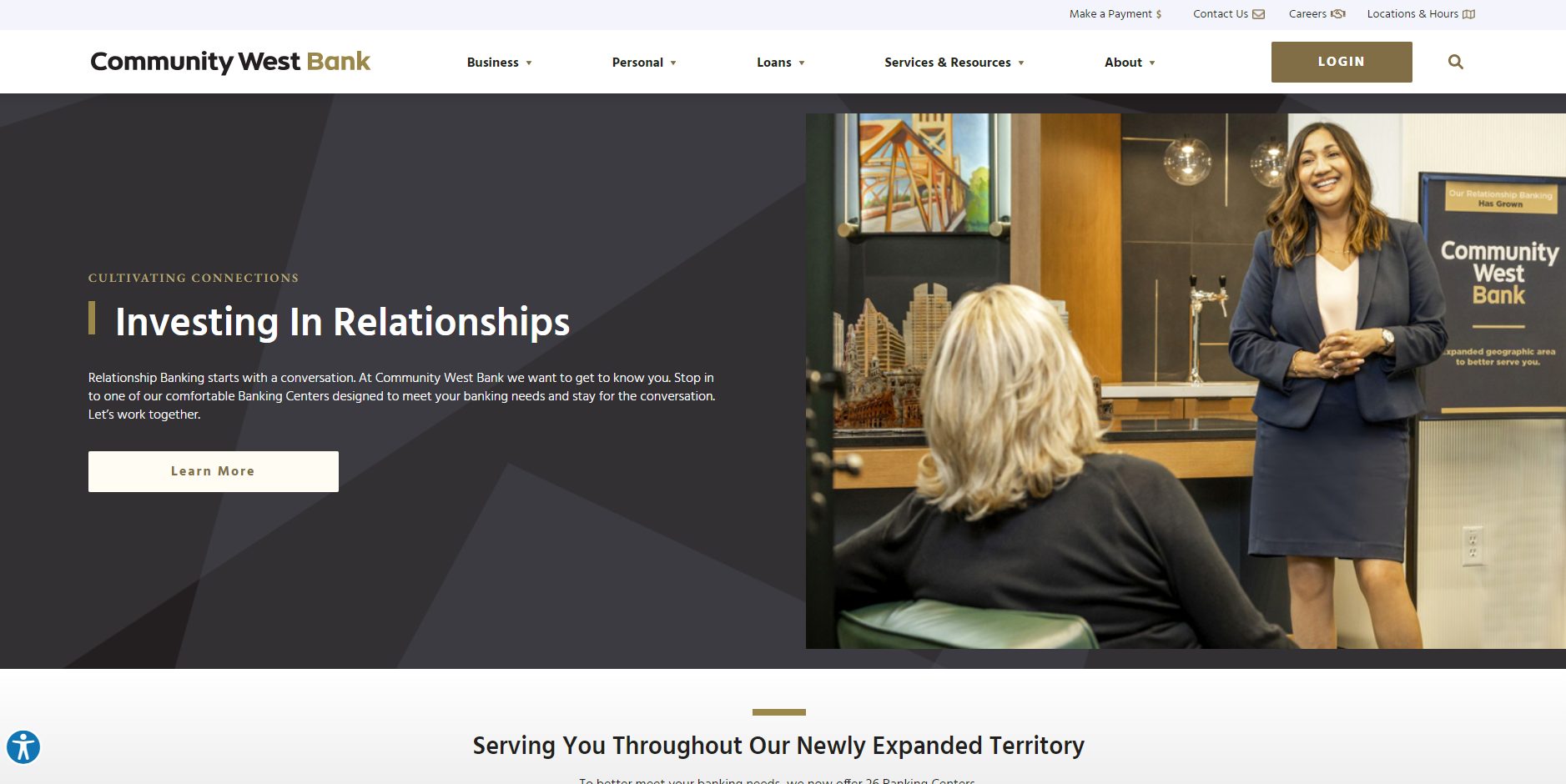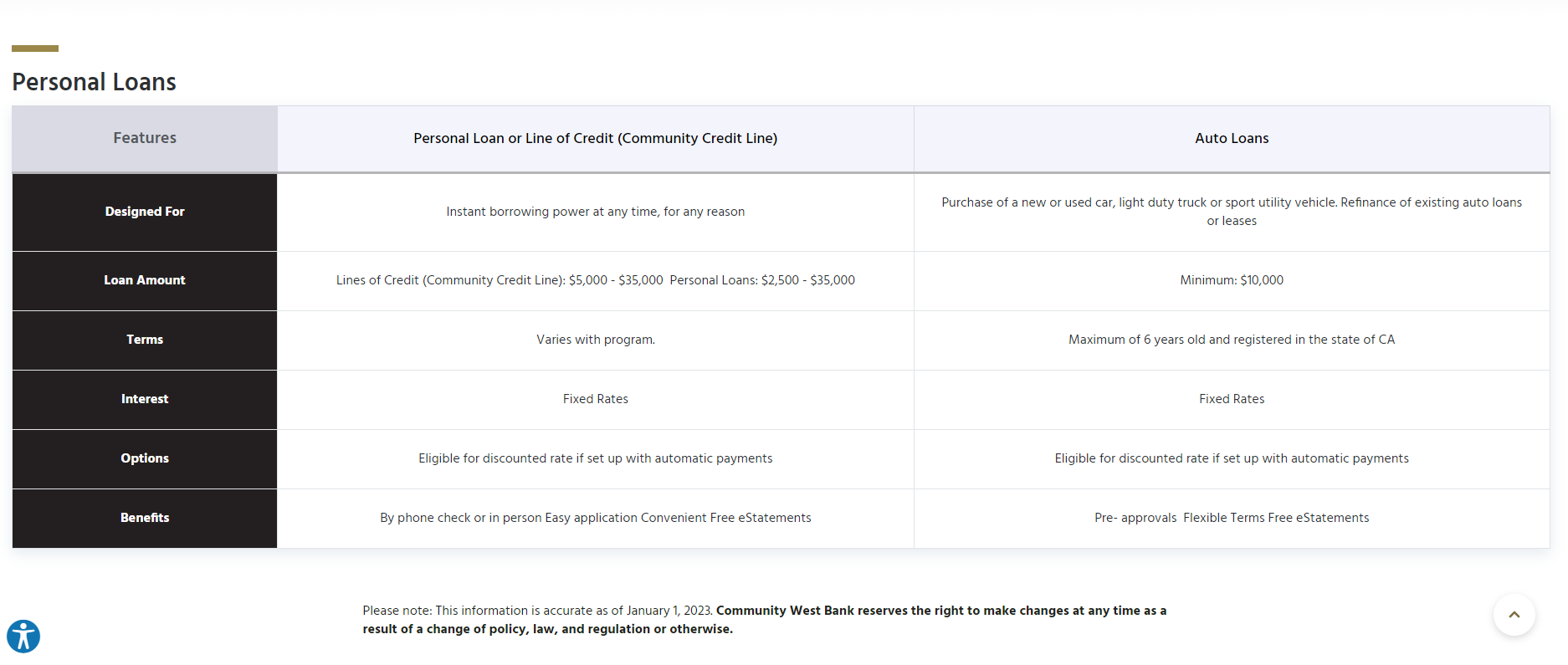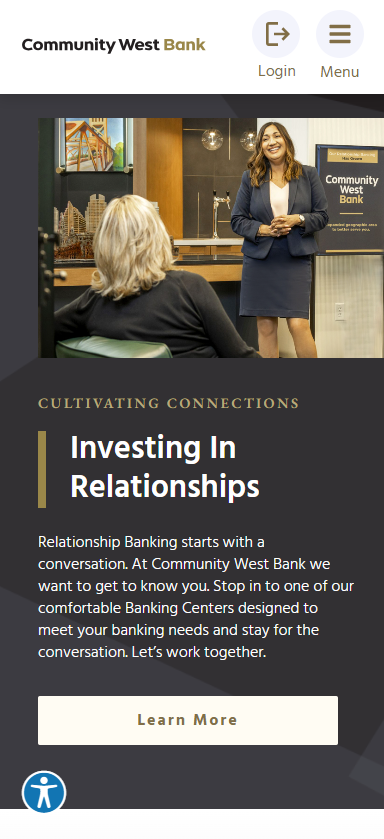Community West Bank
Services we provide:
- Discovery
- Strategy
- UX/UI design
- Website development
- Xperience by Kentico implementation
About Community West Bank
CWB is a large community bank in southern California with over 20+ locations and a track record of financial strength, security and stability gained over its 44 years in business. CWB has set itself apart from other banks by its people, dedication to client advocacy, exemplary "relationship banking," strong community support and a mission to exceed expectations. With a passion for providing customized solutions, the merger drove the decision to revamp their digital services to better serve their customers.
The Process
In an era where digital presence is critical to financial institutions and mergers are frequent, the successful merger of Community West Bank (CWB) and Central Valley Bank (CVB) depended on a robust and well-executed digital strategy, critical to providing a seamless user experience for customers and employees. SilverTech, leveraging its expertise in Xperience by Kentico website development, customized a digital solution that unified the brands of these two banks into one cohesive user-friendly digital experience in just 4 months from start to launch.
The Challenges
The merger of CWB and CVB presented unique challenges, particularly in integrating two distinct digital landscapes into a single cohesive website. The biggest challenges included:
- Differing Content Strategies: CWB's site was optimized for SEO with a rich content library, while CVB's site focused more on detailed product pages. Balancing these different content approaches was crucial.
- Short Timeline: The project needed to be completed with a demanding timeline, delivering a high-quality, functional website, from planning to launch in less than four months.
- Outdated Technology: The old CWB site suffered from poor mobile optimization, slow speeds, outdated information, and a lack of interactive features. This hindered customer engagement and usability.
Goals for New Site
SilverTech identified four main goals for CWB's new website with the main goal of unifying the brands. The merger of the two banks presented a unique opportunity to take advantage of the best from both brands.
Solution and Implementation
Based on the insight gained, SilverTech devised a comprehensive strategy roadmap to address the challenges and deliver a seamless digital experience for the bank merger. It was SilverTech's recommendation that Kentico's newest hybrid CMS platform Xperience by Kentico would be the best solution for the new website. Xperience with robust features and functionality allowed SilverTech to create an exceptional digital user experience efficiently for CWB.
The Key components of the solution include:
- Unified Content Strategy: SilverTech developed a content migration plan that combined the SEO-rich content from CWB with the detailed product information from CVB. This approach ensured that the new site would benefit from both banks' strengths while avoiding duplication and inconsistencies.
- Modern Design and Functionality: The new website was built with Xperience by Kentico, featuring a modern, responsive design to enhance user experience across all devices. Key features included:
- Enhanced Interactivity: Interactive elements and engaging content to improve customer interaction and retention
- Improved CTAs: Clear, strategically placed CTAs to guide users through the site effectively
- Technical Upgrades: Faster loading speeds, improved reliability, and mobile optimization to ensure a smooth user experience
- New Functionalities: Inclusion of essential tools like product comparison tools, branch locator and more
- Accelerated Development Timeline: Despite the tight timeline, SilverTech employed agile development practices to ensure timely delivery without compromising quality. The team worked in sprints to continuously test and refine the site, leading up to a successful launch within the four-month timeframe.
HIGHLIGHTS
Exceptions to Web Content and Mobile App Accessibility Requirements for State and Local Governments
By: Paul Creme | 2/26/25
On April 24, 2024, the Federal Register published the Department of Justice’s final rules for Title II of the Americans with Disabilities Act as amended (the “ADA”). The rules are considered the technical standard for web content and mobile apps; Web Content Accessibility Guidelines (WCAG) Version 2.1, Level AA.
The rules ensure state and local government services, programs, and activities are available and accessible on websites and mobile apps for people with disabilities. As implementation clarity is non-negotiable, there are some exceptions that do not require web and mobile app content to comply with WCAG 2.1, Level AA.
THE EXCEPTIONS:
Archived Web Content
Information that may be rarely used or is outdated, not needed, or repeated somewhere else. The web content must meet all four of the following points to be considered an exception to the requirements:
- 1. The content was created prior to the effective date or reproduces paper documents or the contents of other physical media.
- 2. The content is kept only for reference, research, or recordkeeping.
- 3. The content is kept in a special area for archived content.
- 4. The content has not been changed since it was archived.
Preexisting Conventional Electronic Documents
Documents that meet both of the following points are not required to meet WCAG 2.1, Level AA:
- 1. The documents are word processing, presentation, PDF, or spreadsheet files.
- 2. They were available on the state or local government’s website or mobile app before the required date the state or local government must comply with this rule.
The exception does not apply if the documents are currently being used to apply for, access, or participate in a state or local government’s services and/or programs. Even if they were posted before the date the government must comply with the rule.
Contractual, Licensing, or Other Arrangements with a Public Entity
Content posted by a third party where said third party is not posting due to contractual, licensing, or other arrangements with a public entity. This may include such things as meeting notices by non-governmental entities.
Individualized Password-Protected Documents
Documents that meet all three of the following points do not need to meet WCAG 2.1, Level AA:
- 1. The documents are word processing, presentation, PDF, or spreadsheet files.
- 2. The documents are about a specific person, property, or account.
- 3. The documents are password-protected or otherwise secured.
This could include payment portals.
Preexisting Social Media Posts
If the state or local governmental entity is unable to meet the new requirements there are some alternatives such as having two versions of the same web and mobile app content. In other words, one version that is not accessible and another version that is accessible and provides all the same information and features. The second version is called a “conforming alternate version.” However, the entity may not have a main web page that is inaccessible and a separate accessible version of the same content, because people with disabilities should get equal access to that content on the same page.
Technicalities & Timing
In some limited situations, state and local governments may be able to show that their web content or mobile apps have minor attributes that do not meet WCAG Version 2.1, Level AA. In these cases, the issue would have to be so small that it would not interfere with the accessibility of the content or mobile app.
State and local governments cannot use this part of the rule to avoid compliance, and if web content does not fully meet WCAG 2.1, Level AA, there are many things the government would have to prove to show they are not in violation of the rule.
State and local governments must make sure their web content and mobile apps meet WCAG 2.1, Level AA within 2 - 3 years of when the rule was published (April 24, 2024), depending on their population. In other words, state and local entities have about 2 years to enforce fully compliant sites and mobile apps unless an exemption applies.
You can find more information about why the Department of Justice is enforcing these compliance requirements and their timelines here under “Requirements by Entity Size.” Please reach out if you have any questions regarding your website's compliance.




